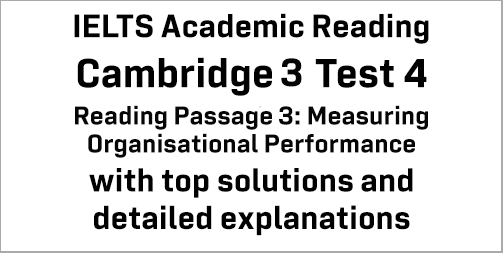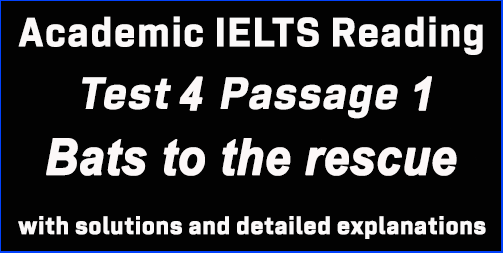IELTS Academic Reading: Cambridge 3 Test 4 Reading passage 3; Measuring Organisational Performance; with best solutions and best explanations
This Academic IELTS Reading post focuses on solutions to IELTS Cambridge 3 Reading Test 4 Reading Passage 3 which is titled ‘Measuring Organisational Performance’. This is a targeted post for IELTS candidates who have big problems finding out and understanding Reading Answers in the AC module. This post can guide you the best to understand every Reading answer without much trouble. Finding out IELTS Reading answers is a steady process, and this post will assist you in this respect.
IELTS Cambridge 3 Test 4: AC Reading Module
Reading Passage 3: Questions 28-40
The title of the passage: Measuring Organisational Performance
Questions 28-30: Multiple choice questions
[This type of question asks you to choose a suitable answer from the options using the knowledge you gained from the passage. Generally, this question is set found as the last question set in most passages so you should not worry much about it. Finding all the answers for previous questions gives you a good idea about these questions.]
Question no. 28: The experiment was designed to –
Keywords for the question: experiment, designed to,
In the first paragraph, the author of the text provides ‘clear evidence’ that increase in productivity is important and it can be attained by supervision but it needs substantial cost. The author says here, “There is clear-cut evidence that, for a period of at least one year, supervision which increases the direct pressure for productivity can achieve significant increases in production. However, such short-term increases are obtained only at a substantial and serious cost to the organisation.”
Then, in the second paragraph, the author says, “To what extent can a manager make an impressive earnings record over a short period of one to three years by exploiting the company’s investment in the human organisation in his plant or division? To what extent will the quality of his organisation suffer if he does so? The following is a description of an important study conducted by the Institute for Social Research designed to answer these questions.”
Here, the author says that the study or experiment is designed to answer the questions which indicate whether increased productivity should be sought at any cost.
So, the answer is: A (establish whether increased productivity should be sought at any cost)
Question no. 29: The four divisions
Keywords for the question: four divisions,
In the third paragraph, the author writes, “The study covered 500 clerical employees in four parallel divisions. Each division was organised in exactly the same way, used the same technology, did exactly the same kind of work, and had employees of comparable aptitudes.”
Here, exactly the same way = identical patterns,
So, the answer is: C (had identical patterns of organisation)
Question no. 30: Before the experiment
Keywords for the question: before, experiment,
The first two lines of paragraph no. 6 say, “The experiment at the clerical level lasted for one year. Beforehand, several months were devoted to planning, and there was also a training period of approximately six months. .. .. .”
Here, several months = a number of months,
So, the answer is: C (the staff involved spent a number of months preparing for the study)
Questions 31-36: Summary completion
[In this kind of questions candidates are given a summary for one, two or three paragraphs with some fill in the blanks questions. Candidates need to find out the related paragraphs by correctly studying the keywords from the questions. Then, they should follow the steps of finding answers for fill in the gaps.]
Question no. 31: This experiment involved an organisation comprising four divisions, which were divided into two programmes: the hierarchically controlled programme and the participative programme. For a period of one year a different method of _________ was used in each programme.
Keywords for the question: experiment, four divisions, two programmes, hierarchically controlled programme, participative programme, a period of one year, a different method, used, each programme,
At the beginning of paragraph no. 6 the author says, “The experiment at the clerical level lasted for one year. .. .. .”
Then, take a look at the last few lines of paragraph no. 7.The author of the text says here at the beginning, “Turning now to the heart of the study, in two divisions an attempt was made to change the supervision so that the decision levels were pushed down and detailed supervision of the workers reduced. .. .. .”
These lines indicate that a different method of supervision was used in each programme for a period of one year.
So, the answer is: supervision
Question no. 32: Throughout this time ________ was calculated on a weekly basis.
Keywords for the question: throughout this time, calculated, weekly basis,
The answer is in paragraph no. 6. The writer says here in lines 2-3, “ . .. . . Productivity was measured continuously and computed weekly throughout the year. .. . .. .”
Here, measured = calculated, throughout the year = throughout this time,
So, the answer is: productivity
Question no. 33:
- supervision of all workers was ________
Keywords for the question: participative programme, supervision, all workers,
At the beginning of paragraph no. 7, the author says, “Turning now to the heart of the study, in two divisions an attempt was made to change the supervision so that the decision levels were pushed down and detailed supervision of the workers reduced. . . ..”
So, the answer is: reduced
Question no. 34:
- supervisory staff were given training in ________
Keywords for the question: participative programme, supervisory staff, given, training,
In lines 2-4 of paragraph no. 7, the writer says, “ . . .. . More general supervision of the clerks and their supervisors was introduced. In addition, the managers, assistant managers, supervisors and assistant supervisors of these two divisions were trained in group methods of leadership, .. .. .”
Here, supervisors and assistant supervisors = supervisory staff, were trained = were given training,
So, the answer is: (group methods of) leadership
Question no. 35:
- work groups were found to be _________ by 30%.
Keywords for the question: hierarchically controlled programme, work groups, found to be, by 30%,
Have a look at lines 5-6 of paragraph no. 8, “ . . . This showed that these divisions were overstaffed by about 30%. .. .. ..”
So, the answer is: overstaffed
Question no. 36:
- the work force was _________ by 25%.
Keywords for the question: hierarchically controlled programme, work force, by 25%,
Again, take a look at lines 6-7 of paragraph no. 8, “ . . . The general manager then ordered the managers of these two divisions to cut staff by 25%. .. .. .”
So, the answer is: cut
Questions 37-40: YES, NO, NOT GIVEN
[In this type of question, candidates are asked to find out whether:
The statement in the question matches with the claim of the writer in the text- YES
The statement in the question contradicts with the claim of the writer in the text- NO
The statement in the question has no clear connection with the account in the text- NOT GIVEN
TIPS: For this type of question, you can divide each statement into three independent pieces and make your way through with the answer.]
Question no. 37: Fig 1

In the ‘Results of the Experiment’ section of the passage, take look at the first paragraph. In the first lines, the author explains, “Figure 1 shows the changes in salary costs per unit of work, which reflect the change in productivity that occurred in the divisions. .. .. .”
So, the answer is: C (Changes in productivity)
Question no. 38: Fig 2

Again, the ‘Results of the Experiment’ section of the passage, lines 1-2 of paragraph no. 4 say, “For example, Figure 2 shows that when more general supervision and increased participation were provided, the employees’ feeling of responsibility to see that the work got done increased.. . … ..”
Here, the work got done = completion of work,
So, the answer is: D (Employees’ feelings of responsibility towards completion of work)
Question no. 39: Fig 3

The first lines of the final paragraph say, “As Figure 3 shows, the employees in the participative programme at the end of the year felt that their manager and assistant manager were ‘closer to them’ than at the beginning of the year.
Here, manager and assistant manager = supervisors,
So, the answer is: G (Employees feel closer to their supervisors)
Question no. 40: Fig 4

In the final paragraph, lines 3-5 say, “ . .. . . Moreover, as Figure 4 shows, employees in the participative programme felt that their supervisors were more likely to ‘pull’ for them, or for the company and them, and not be solely interested in the company, while in the hierarchically controlled programme, the opposite trend occurred.”
Here, supervisors were more likely to ‘pull’ for them = extent of personal support from management,
So, the answer is: F (Employees’ opinion as to extent of personal support from management)
Click here for solutions to Cambridge 3 Test 4 Reading passage 1
Click here for solutions to Cambridge 3 Test 4 Reading passage 2




2 thoughts on “IELTS Academic Reading: Cambridge 3 Test 4 Reading passage 3; Measuring Organisational Performance; with best solutions and best explanations”